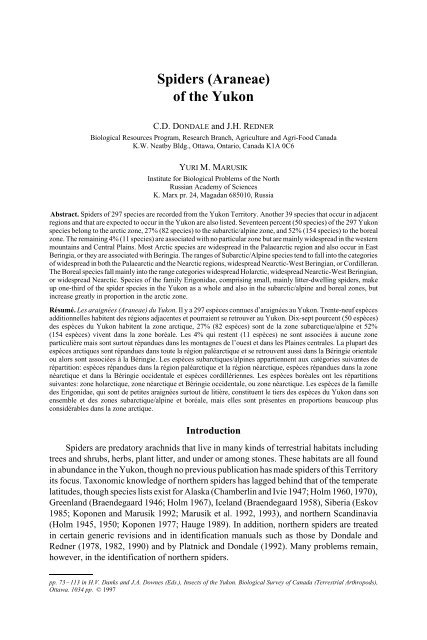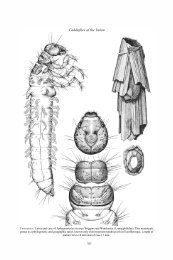Spiders of the Yukon - Department of Biological Sciences
Spiders of the Yukon - Department of Biological Sciences
Spiders of the Yukon - Department of Biological Sciences
Create successful ePaper yourself
Turn your PDF publications into a flip-book with our unique Google optimized e-Paper software.
<strong>Spiders</strong> (Araneae)<br />
<strong>of</strong> <strong>the</strong> <strong>Yukon</strong><br />
C.D. DONDALE and J.H. REDNER<br />
<strong>Biological</strong> Resources Program, Research Branch, Agriculture and Agri-Food Canada<br />
K.W. Neatby Bldg., Ottawa, Ontario, Canada K1A 0C6<br />
YURI M. MARUSIK<br />
Institute for <strong>Biological</strong> Problems <strong>of</strong> <strong>the</strong> North<br />
Russian Academy <strong>of</strong> <strong>Sciences</strong><br />
K. Marx pr. 24, Magadan 685010, Russia<br />
Abstract. <strong>Spiders</strong> <strong>of</strong> 297 species are recorded from <strong>the</strong> <strong>Yukon</strong> Territory. Ano<strong>the</strong>r 39 species that occur in adjacent<br />
regions and that are expected to occur in <strong>the</strong> <strong>Yukon</strong> are also listed. Seventeen percent (50 species) <strong>of</strong> <strong>the</strong> 297 <strong>Yukon</strong><br />
species belong to <strong>the</strong> arctic zone, 27% (82 species) to <strong>the</strong> subarctic/alpine zone, and 52% (154 species) to <strong>the</strong> boreal<br />
zone. The remaining 4% (11 species) are associated with no particular zone but are mainly widespread in <strong>the</strong> western<br />
mountains and Central Plains. Most Arctic species are widespread in <strong>the</strong> Palaearctic region and also occur in East<br />
Beringia, or <strong>the</strong>y are associated with Beringia. The ranges <strong>of</strong> Subarctic/Alpine species tend to fall into <strong>the</strong> categories<br />
<strong>of</strong> widespread in both <strong>the</strong> Palaearctic and <strong>the</strong> Nearctic regions, widespread Nearctic-West Beringian, or Cordilleran.<br />
The Boreal species fall mainly into <strong>the</strong> range categories widespread Holarctic, widespread Nearctic-West Beringian,<br />
or widespread Nearctic. Species <strong>of</strong> <strong>the</strong> family Erigonidae, comprising small, mainly litter-dwelling spiders, make<br />
up one-third <strong>of</strong> <strong>the</strong> spider species in <strong>the</strong> <strong>Yukon</strong> as a whole and also in <strong>the</strong> subarctic/alpine and boreal zones, but<br />
increase greatly in proportion in <strong>the</strong> arctic zone.<br />
Résumé. Les araignées (Araneae) du <strong>Yukon</strong>. Il y a 297 espèces connues d’araignées au <strong>Yukon</strong>. Trente-neuf espèces<br />
additionnelles habitent des régions adjacentes et pourraient se retrouver au <strong>Yukon</strong>. Dix-sept pourcent (50 espèces)<br />
des espèces du <strong>Yukon</strong> habitent la zone arctique, 27% (82 espèces) sont de la zone subarctique/alpine et 52%<br />
(154 espèces) vivent dans la zone boréale. Les 4% qui restent (11 espèces) ne sont associées à aucune zone<br />
particulière mais sont surtout répandues dans les montagnes de l’ouest et dans les Plaines centrales. La plupart des<br />
espèces arctiques sont répandues dans toute la région paléarctique et se retrouvent aussi dans la Béringie orientale<br />
ou alors sont associées à la Béringie. Les espèces subarctiques/alpines appartiennent aux catégories suivantes de<br />
répartition: espèces répandues dans la région paléarctique et la région néarctique, espèces répandues dans la zone<br />
néarctique et dans la Béringie occidentale et espèces cordillériennes. Les espèces boréales ont les répartitions<br />
suivantes: zone holarctique, zone néarctique et Béringie occidentale, ou zone néarctique. Les espèces de la famille<br />
des Erigonidae, qui sont de petites araignées surtout de litière, constituent le tiers des espèces du <strong>Yukon</strong> dans son<br />
ensemble et des zones subarctique/alpine et boréale, mais elles sont présentes en proportions beaucoup plus<br />
considérables dans la zone arctique.<br />
Introduction<br />
<strong>Spiders</strong> are predatory arachnids that live in many kinds <strong>of</strong> terrestrial habitats including<br />
trees and shrubs, herbs, plant litter, and under or among stones. These habitats are all found<br />
in abundance in <strong>the</strong> <strong>Yukon</strong>, though no previous publication has made spiders <strong>of</strong> this Territory<br />
its focus. Taxonomic knowledge <strong>of</strong> nor<strong>the</strong>rn spiders has lagged behind that <strong>of</strong> <strong>the</strong> temperate<br />
latitudes, though species lists exist for Alaska (Chamberlin and Ivie 1947; Holm 1960, 1970),<br />
Greenland (Braendegaard 1946; Holm 1967), Iceland (Braendegaard 1958), Siberia (Eskov<br />
1985; Koponen and Marusik 1992; Marusik et al. 1992, 1993), and nor<strong>the</strong>rn Scandinavia<br />
(Holm 1945, 1950; Koponen 1977; Hauge 1989). In addition, nor<strong>the</strong>rn spiders are treated<br />
in certain generic revisions and in identification manuals such as those by Dondale and<br />
Redner (1978, 1982, 1990) and by Platnick and Dondale (1992). Many problems remain,<br />
however, in <strong>the</strong> identification <strong>of</strong> nor<strong>the</strong>rn spiders.<br />
pp. 73 – 113 in H.V. Danks and J.A. Downes (Eds.), Insects <strong>of</strong> <strong>the</strong> <strong>Yukon</strong>. <strong>Biological</strong> Survey <strong>of</strong> Canada (Terrestrial Arthropods),<br />
Ottawa. 1034 pp. © 1997

















